The Environmental Impacts of Radio Frequency and Power Line Communication for Advanced Metering Infrastructures in Smart Grids
Abstract
:1. Introduction
2. NB-PLC and RF Characterization
2.1. NB-PLC Characterization
2.1.1. NB-PLC Attenuation
2.1.2. NB-PLC Noise
2.2. RF Characterization
2.2.1. RF Attenuation
2.2.2. RF Noise
3. Environment Characterization
3.1. Rural Environment
3.2. Urban Environment
3.3. Industrial Environment
3.4. Proposed Methodology
- The choice of RF and PLC standards in compliance with the AMI-NAN system: The authors study the choice of Wi-SUN for RF and G3-PLC for NB-PLC. In fact, for the RF link, Wi-SUN allows utilities to monitor and control the electrical grid more efficiently, leading to improved energy management and reliability. Moreover, it supports mesh networking, allowing devices to communicate with each other via multiple paths. For the PLC link, IEEE 1901.2 is a standard for narrowband orthogonal frequency division multiplexing (NB-OFDM) PLC technology. The use of OFDM, which is known for its ability to handle multipath propagation and mitigate the effects of noise and interference, makes communication robust in challenging environments.
- The choice of models for RF and PLC channels: The authors outline the key characteristics of wireless and narrowband power line systems. A bottom-up approach is used for the NB-PLC channel. For the attenuation of the RF channel, the Rayleigh fading model is adopted as it shows the effects of small-scale fading of non-line-of-sight reproduction in wireless communications.
- The environment model design: The authors focus on the environment model design to characterize the RF and NB-PLC channels in distinct geographical environments—rural, urban, and industrial. These characteristics play a crucial role in shaping the design and effectiveness of the AMI system.
- Analysis of performances regarding the BER and link selection for each environment: The authors compare NB-PLC and RF performances for the following three environments, rural, urban, and industrial.
4. Simulation Results
4.1. OFDM Communication System
4.2. Simulation Parameters
4.3. Rural Environment
4.4. Urban Environment
4.5. Industrial Environment
4.6. Discussion
- -
- Rural Environment: Simulation results suggest that the RF link demonstrates better performance in rural areas. Since they typically have lower population density and less electromagnetic interference, the use of the RF link can be more feasible and provide reliable communication with better performance. Interestingly, PLC can be a valid option even in low-density rural areas if repeaters can be installed. In this viewpoint, the protocol choice is crucial. The G3 or PRIME protocol has a mechanism to promote simple nodes to relay nodes and automatically build networks. This kind of protocol can be exploited in order to obtain a strong interconnected and reliable PLC network.
- -
- Industrial Environment: Simulation results indicate that NB-PLC can be more suitable for industrial areas, likely due to the advantages mentioned earlier, such as the presence of abundant power lines, signal penetration, interference immunity, and noise rejection.
- -
- Urban Environment: The choice between the RF link and NB-PLC for communication between the SM and DC in an AMI system is more complicated and it depends on the density of the area. The decision between them in this scenario depends on other factors, such as infrastructure availability, cost considerations, and specific application requirements. The communication between the SM and DC is affected by multipath propagation and external interferences. This limits network performances in terms of reliability and availability. Therefore, additional schemes, such as repeaters or error correcting codes, are needed to improve the link reliability requirements.
5. Conclusions
Author Contributions
Funding
Institutional Review Board Statement
Informed Consent Statement
Data Availability Statement
Acknowledgments
Conflicts of Interest
References
- Aguiar-Pérez, J.; Pérez-Juarez, M. An Insight of Deep Learning Based Demand Forecasting in Smart Grids. Sensors 2023, 23, 1467. [Google Scholar] [CrossRef]
- G3-PLC Powerline Communication Standard for Today’s Smart Grid Presentation, G3-PLC Alliance. Available online: http://www.g3-plc.com/content/presentations (accessed on 20 July 2023).
- Galli, S.; Scaglione, A.; Wang, Z. For the Grid and Through the Grid: The Role of Power Line Communications in the Smart Grid. IEEE Proc. 2011, 99, 998–1027. [Google Scholar] [CrossRef]
- ZigBee Specification, ZigBee Alliance. 2015. Available online: https://zigbeealliance.org/wp-content/uploads/2019/11/docs-05-3474-21-0csg-zigbee-specification.pdf (accessed on 14 July 2023).
- UMTS Long Term Evolution, (LTE)—Technology Introduction, Rohde & Schwarz. Available online: http://www.rohde-schwarz.com/en/applications/umts-long-term-evolution-lte-technologyintroduction-application-note_56280-15658.html (accessed on 22 July 2023).
- Andreadou, N.; Guardiola, M.; Fulli, G. Telecommunication Technologies for Smart Grid Projects with Focus on Smart Metering Applications. Energies 2016, 9, 375. [Google Scholar] [CrossRef]
- Maalej, A.; Ben-Romdhane, M.; Rebai, C.; Ghazel, A.; Desgreys, P.; Loumeau, P. Toward Time-Quantized Pseudorandom Sampling for Green Communication. IEEE Trans. Circuits Syst. II Express Briefs 2014, 61, 443–447. [Google Scholar] [CrossRef]
- IEEE Std 802.15.4g-2012 (Amendment to IEEE Std 802.15.4-2011); IEEE Standard for Local and Metropolitan Area Networks–Part 15.4: Low-Rate Wireless Personal Area Networks (LR-WPANs) Amendment 3: Physical Layer (PHY) Specifications for Low-Data-Rate, Wireless, Smart Metering Utility Networks. IEEE Computer Society: New York, NY, USA, 2012; pp. 1–252. [CrossRef]
- Khorov, E.; Lyakhov, A.; Krotov, A.; Guschin, A. A survey on IEEE 802.11ah: An enabling networking technology for smart cities. Comput. Commun. 2015, 58, 53–69. [Google Scholar] [CrossRef]
- Kuzlu, Z.; Pipattanasomporn, M. A comprehensive review of communication technologies for street lighting applications in smart cities. In Communication Technologies for Networked Smart Cities; IET Digital Library: Germany, 2021. [Google Scholar]
- Berganza, I.; Sendin, A.; Arriola, J. PRIME: Powerline Intelligent Metering Evolution. CIRED Seminar 2008: SmartGrids for Distribution; IET Digital Library: Germany, 2008; pp. 1–3. [Google Scholar] [CrossRef]
- Oksman, V.; Zhang, J.G. HNEM: The new ITU-T standard on narrowband PLC technology. IEEE Commun. Mag. 2011, 49, 36–44. [Google Scholar] [CrossRef]
- IEEE Std 1901.2-2013; IEEE Standard for Low-Frequency (Less Than 500 kHz) Narrowband Power Line Communications for Smart Grid Applications. IEEE Computer Society: New York, NY, USA, 2013; pp. 1–269. [CrossRef]
- Upadhyay, A.; Gupta, A.; Kumar, V. Comparative study of narrowband PLCs physical layer under AWGN and narrowband interferer. In Proceedings of the Annual IEEE India Conference (INDICON), New Delhi, India, 17–20 December 2015; pp. 1–4. [Google Scholar] [CrossRef]
- Artale, G.; Maalej, A.; Ben Rhouma, O.; Ben-Romdhane, M.; Ben Othman, N.; Cataliotti, A.; Cosentino, V.; Culcasi, A.; Fiorino, M.; Guaiana, S.; et al. Innovative solutions for the integration of renewable energies on Tunisian and Sicilian electrical grids. In Proceedings of the IEEE BLORIN 2022–1st Workshop on BLOckchain for Renewables Integration, Palermo, Italy, 2–3 September 2022. [Google Scholar]
- Artale, G.; Caravello, G.; Cataliotti, A.; Cosentino, V.; Ditta, V.; Di Cara, D.; Guaiana, S.; Panzavecchia, N.; Tinè, G.A. PLC based monitoring and remote control architecture for Distributed Generation and Storage systems in LV smart grids. In Proceedings of the IEEE Forum on Research and Technologies for Society and Industry–IEEE RTSI 2021, Naples, Italy, 6–9 September 2021. [Google Scholar] [CrossRef]
- Artale, G.; Caravello, G.; Cataliotti, A.; Cosentino, V.; Di Cara, D.; Fiorelli, R.; Guaiana, S.; Panzavecchia, N.; Tinè, G. A Line Impedance Calculator Based on a G3 PLC Modem Platform. IEEE Trans. Instrum. Meas. 2022, 71, 1–10. [Google Scholar] [CrossRef]
- Usman, A.; Shami, S.H. Evolution of Communication Technologies for Smart Grid applications. Renew. Sustain. Energy Rev. 2013, 19, 191–199. [Google Scholar] [CrossRef]
- Razazian, K.; Umari, M.; Kamalizad, A.; Loginov, A.; Navid, M. G3-PLC specification for powerline communication: Overview, system simulation and field trial results. In Proceedings of the ISPLC2010, Rio de Janeiro, Brazil, 28–31 March 2010; pp. 313–318. [Google Scholar] [CrossRef]
- Lavenu, C.; Chauvenet, C.; Treffiletti, P.; Varesio, M.; Hueske, K. Standardization Challenges, Opportunities and Recent Evolutions for the G3-PLC Technology. Energies 2021, 14, 1937. [Google Scholar] [CrossRef]
- Avram, S. Power line communication channel noise source detection using smart meters. In Proceedings of the 12th IEEE International Symposium on Electronics and Telecommunications (ISETC), Timisoara, Romania, 27–28 October 2016; pp. 103–106. [Google Scholar] [CrossRef]
- Shokry, M.; Awad, A.; AbeEllah, M.K.; Khalaf, A.M. Systematic survey of advanced metering infrastructure security: Vulnerabilities, attacks, countermeasures, and future vision. Future Gener. Comput. Syst. 2022, 136, 358–377. [Google Scholar] [CrossRef]
- Paul, J.; Yaacoub, A.; Hernandez, J.; Noura, N.; Chehab, A. Security of Power Line Communication systems: Issues, limitations and existing solutions. Comput. Sci. Rev. 2021, 39, 100331. [Google Scholar] [CrossRef]
- Najarkolaei, A.H.; Hosny, N.; Lota, J. Bit Error Rate Performance in Power Line Communication Channels with Impulsive Noise. In Proceedings of the UKSIM-AMSS International Conference on Modelling and Simulation, Cambridge, UK, 25–27 March 2015. [Google Scholar] [CrossRef]
- Pandey, S. Bit Error Rate (BER) Performance Evaluation of Reference Channel for Power Line Communication (PLC) Channel under Multipath Modeling Technique. Int. Res. J. Eng. Technol. 2018, 5, 1699–1704. [Google Scholar]
- Tangsunantham, N.; Pirak, C. Experimental Performance Analysis of Wi-SUN Channel Modelling Applied to Smart Grid Application. Energies 2022, 15, 2417. [Google Scholar] [CrossRef]
- Ferreira, H.; Lampe, L.; Newbury, J.; Swart, T.G. Power Line Communications: Theory and Applications for Narrowband and Broadband Communications over Power Lines; Wiley: Hoboken, NJ, USA, 2011. [Google Scholar]
- El Sayed, W.; Lezynski, P.; Smolenski, R.; Madi, A.; Pazera, M.; Kempski, A. Deterministic vs. Random Modulated Interference on G3 Power Line Communication. Energies 2021, 14, 3257. [Google Scholar] [CrossRef]
- Fernandez, J.; Omri, A.; Di Pietro, R. PLC Physical Layer Link Identification with Imperfect Channel State Information. Energies 2022, 15, 6055. [Google Scholar] [CrossRef]
- Souissi, S.; BenRhouma, O.; Rebai, C. Bottom-up approach for narrowband powerline channel modeling. In Proceedings of the IEEE Global Communications Conference (GLOBECOM), Atlanta, GA, USA, 9–13 December 2013; pp. 2987–2992. [Google Scholar] [CrossRef]
- Aloui, A.; BenRhouma, O.; Rebai, C. Comparison of different channel modeling techniques used in NB-PLC systems. In Proceedings of the International Conference on Advanced Systems and Electric Technologies (IC_ASET), Hammamet, Tunisia, 22–25 March 2018; pp. 125–131. [Google Scholar] [CrossRef]
- Souissi, S.; Benrhouma, O.; Rebai, C. Design of coupling interface for narrowband Power Line Communication channel characterization. In Proceedings of the International Symposium and 18th International Workshop on ADC Modelling and Testing, Research on Electric and Electronic Measurement for the Economic, Benevento, Italy, 15–17 September 2014. [Google Scholar]
- Souissi, S.; Benrhouma, O.; Rebai, C. On the emulation of narrowband powerline communication noise scenario. In Proceedings of the International Multi-Conference on Systems, Signals and Devices (SSD), Mahdia, Tunisia, 16–19 March 2015. [Google Scholar] [CrossRef]
- Gu, Z.; Liu, H.; Liu, D.; Man, K.L.; Liang, H.; Tan, Z. Modeling the Noise in NarrowBand Power Line Communication. Int. J. Control. Autom. 2016, 9, 41–48. [Google Scholar] [CrossRef]
- Nieman, K.F.; Lin, J.; Nassar, M.; Waheed, K.; Evans, B.L. Cyclic spectral analysis of power line noise in the 3–200 kHz band. In Proceedings of the IEEE 17th International Symposium on Power Line Communications and Its Applications, Johannesburg, South Africa, 24–27 March 2013; pp. 315–320. [Google Scholar] [CrossRef]
- Nassar, M.; Dabak, A.; Kim, I.H.; Pande, T.; Evans, B.L. Cyclostationary noise modeling in narrowband powerline communication for Smart Grid applications. In Proceedings of the IEEE International Conference on Acoustics, Speech and Signal Processing (ICASSP), Kyoto, Japan, 25–30 March 2012; pp. 3089–3092. [Google Scholar] [CrossRef]
- Da Rocha Farias, L.; Monteiro, L.F.; Leme, M.O.; Stevan, S.L. Empirical Analysis of the Communication in Industrial Environment Based on G3-Power Line Communication and Influences from Electrical Grid. Electronics 2018, 7, 194. [Google Scholar] [CrossRef]
- Harada, H.; Mizutani, K.; FUJIWARA, J.; Mochizuki, K.; Obata, K.; Okumura, R. IEEE 802.15.4g Based Wi-SUN Communication Systems. IEICE Trans. Commun. 2017, 100, 1032–1043. [Google Scholar] [CrossRef]
- Mochinski, M.-A.; Vieira, M.; Biczkowski, M.; Chueir, I.; Jamhour, E.; Zambenedetti, V.; Pellenz, M.; Enembreck, F. Towards an Efficient Method for Large-Scale Wi-SUN-Enabled AMI Network Planning. Sensors 2022, 22, 9105. [Google Scholar] [CrossRef]
- Goldsmith, A. Wireless Communications; Cambridge University Press: Cambridge, UK, 2005; pp. 43–50. [Google Scholar]
- M.1225: Guidelines for Evaluation of Radio Transmission Technologies for IMT-2000. Available online: https://www.itu.int/dms_pubrec/itu-r/rec/m/R-REC-M.1225-0-199702-I!!PDF-E.pdf (accessed on 20 October 2021).
- Baidya, B.; Sen, S. Qualitative analysis on Log-Distance propagation for Wlan standard. Indian J. Res. 2014, 3, 69–70. [Google Scholar] [CrossRef]
- Simon, M.K.; Alouini, M.S. Digital Communication over Fading Channels; John Wiley & Sons: Hoboken, NJ, USA, 2005; pp. 18–23. [Google Scholar]
- Nassar, M. Graphical Models and Message Passing Receivers for Interference Limited Communication Systems. Ph.D. Thesis, The University of Texas at Austin, Austin, TX, USA, 17 April 2013. [Google Scholar]
- Austin Interference Modeling and Mitigation Toolbox. Available online: https://users.ece.utexas.edu/~bevans/projects/rfi/software/ (accessed on 25 October 2021).
- Elfeki, I.; Jacques, S.; Aouichak, I.; Doligez, T.; Raingeaud, Y.; Bunetel, J. Characterization of Narrowband Noise and Channel Capacity for Powerline Communication in France. Energies 2018, 11, 3022. [Google Scholar] [CrossRef]
- Prasad, G.; Huo, Y.; Lampe, L.; Leung, V.C.M. Electromagnetic compatibility of power line communications in energy storage units. In Proceedings of the IEEE International Symposium on Power Line Communications and its applications (ISPLC), Manchester, UK, 8–11 April 2018; pp. 1–6. [Google Scholar] [CrossRef]
- Liu, W.; Sigle, M.; Dostert, K. Channel characterization and system verification for narrowband power line communication in smart grid applications. IEEE Commun. Mag. 2011, 49, 28–35. [Google Scholar] [CrossRef]
- Wonnacott, R.; Ching, D.; Chilleri, J.; Safta, C.; Rashkin, L.; Reichardt, T. Industrial PLC Network Modeling and Parameter Identification Using Sensitivity Analysis and Mean Field Variational Inference. Sensors 2023, 23, 2416. [Google Scholar] [CrossRef]
- Sheikh, A.A. Feasibility of NB-PLC in LT power distribution network of electric utility in Pakistan. In Proceedings of the Clemson University Power Systems Conference (PSC), Clemson, SC, USA, 8–11 March 2016; pp. 1–7. [Google Scholar] [CrossRef]
- Kim, D.S.; Chung, B.J.; Chung, Y.M. Analysis of AMI Communication Methods in Various Field Environments. Energies 2020, 13, 5185. [Google Scholar] [CrossRef]



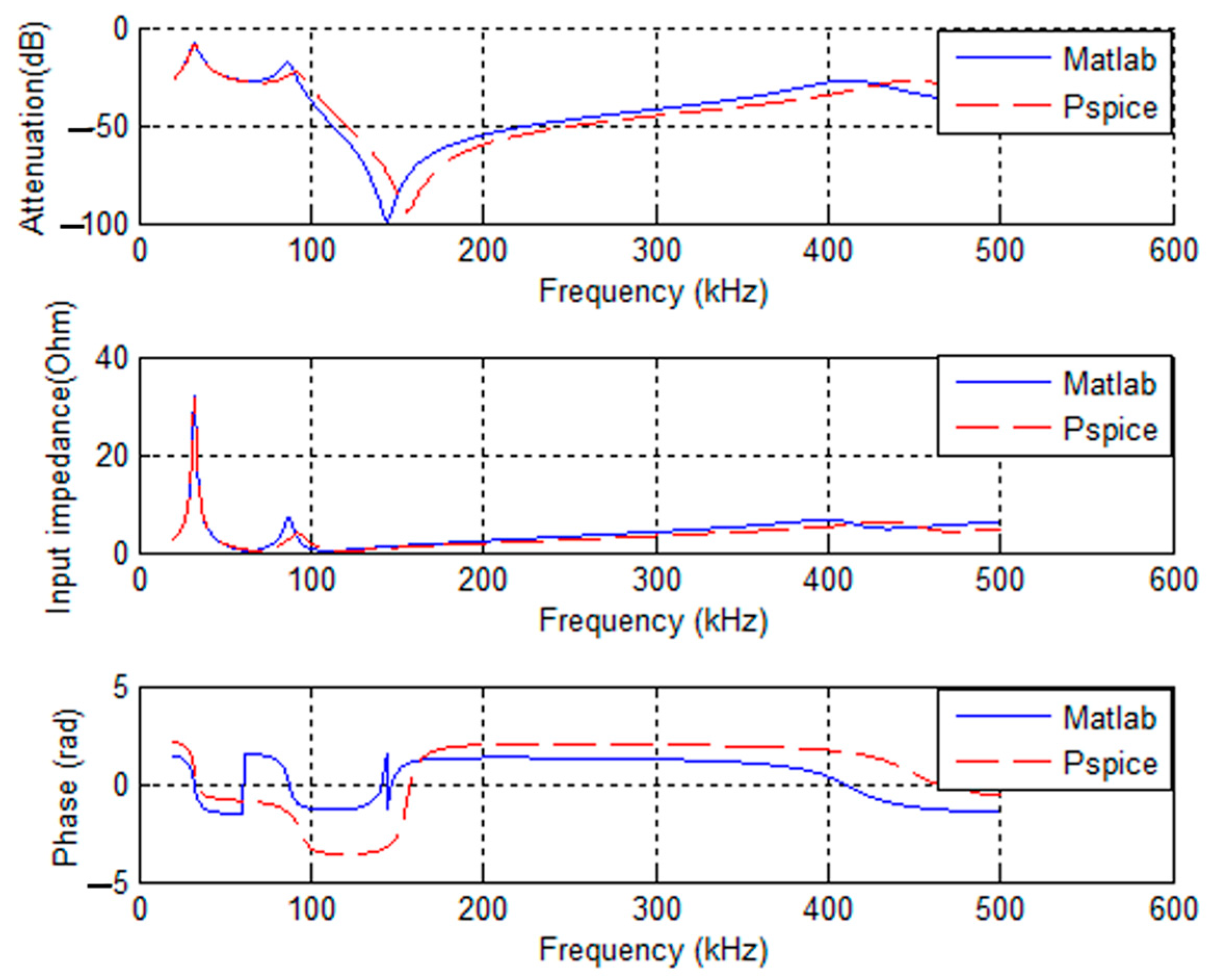
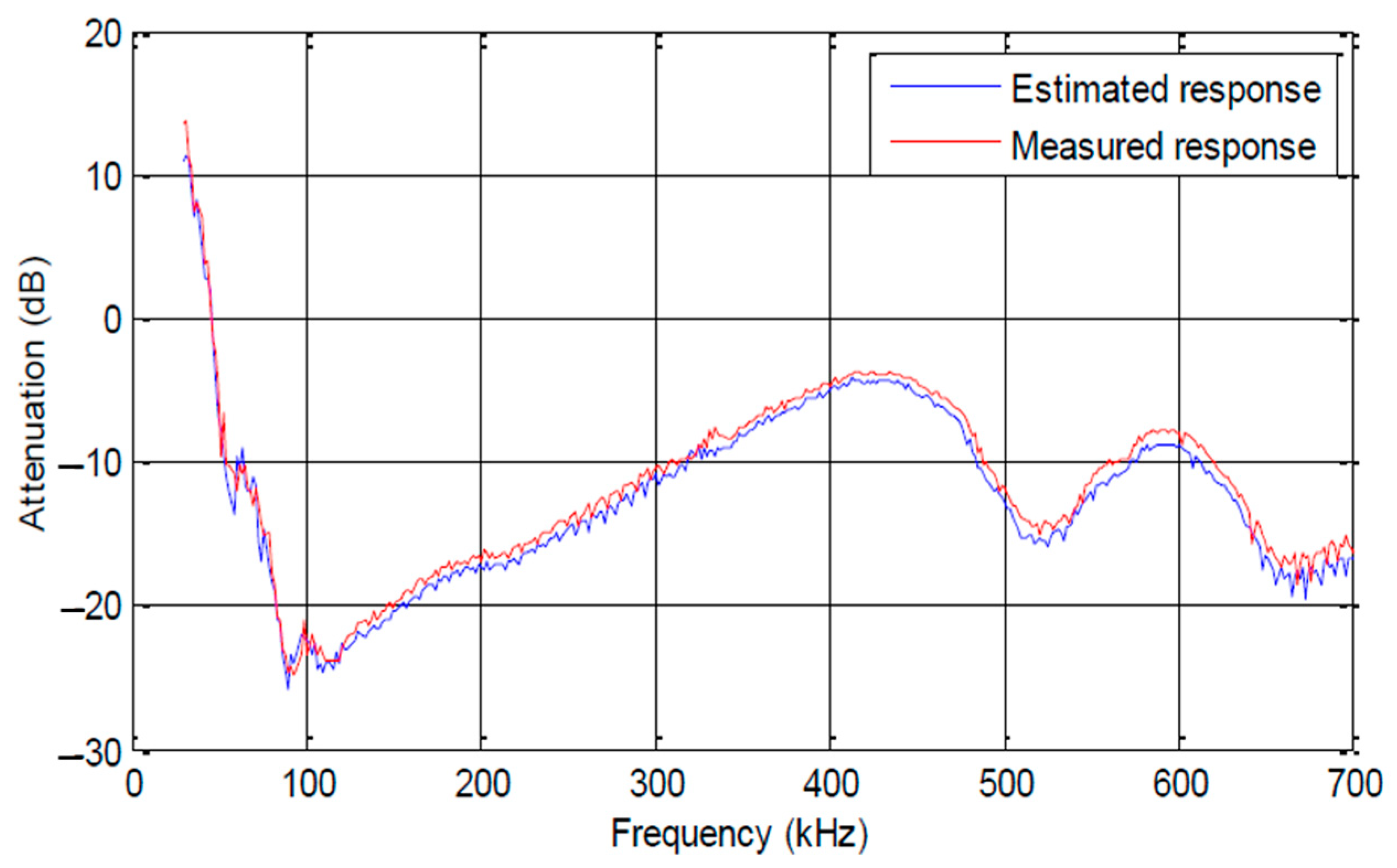
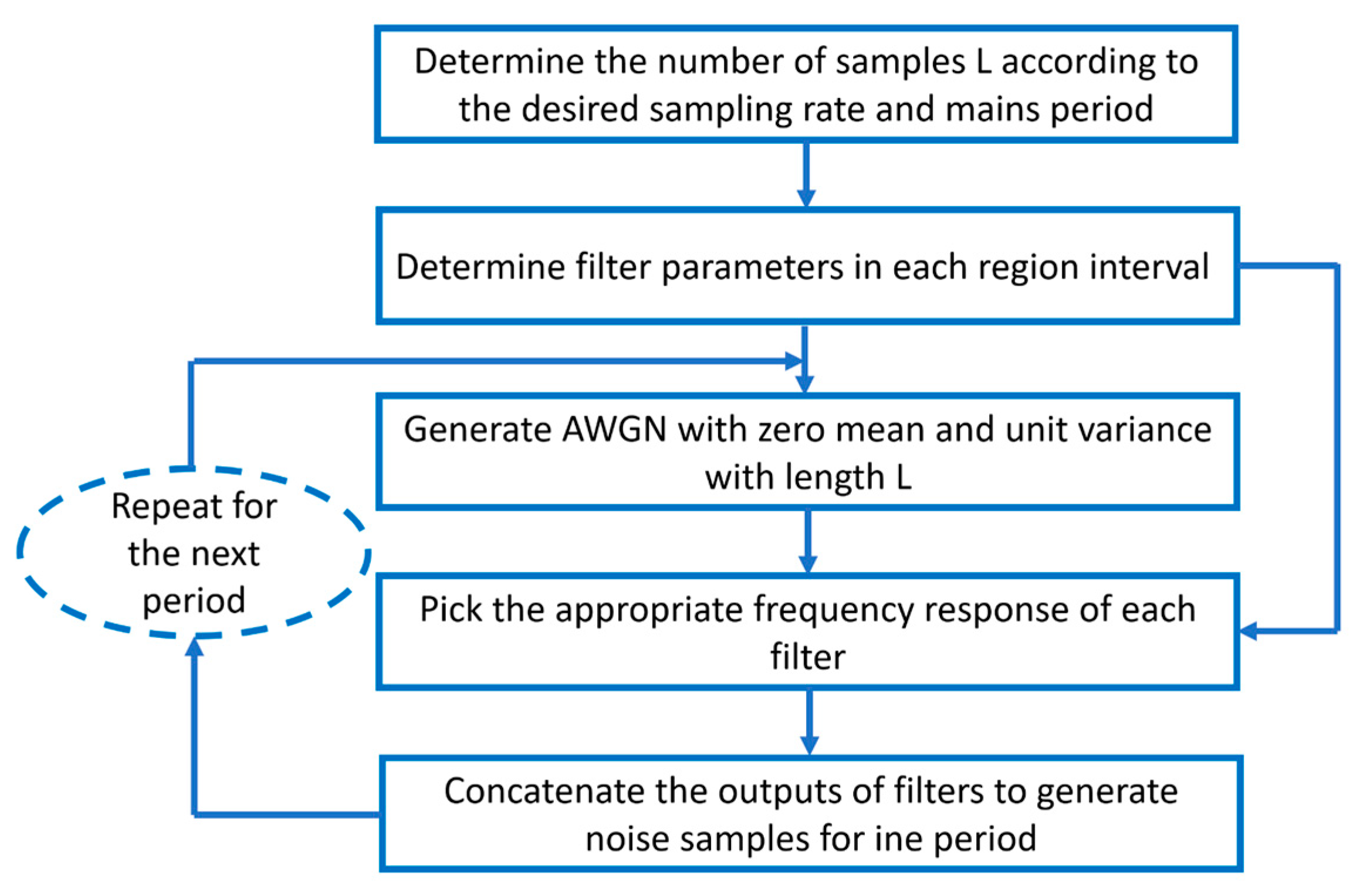
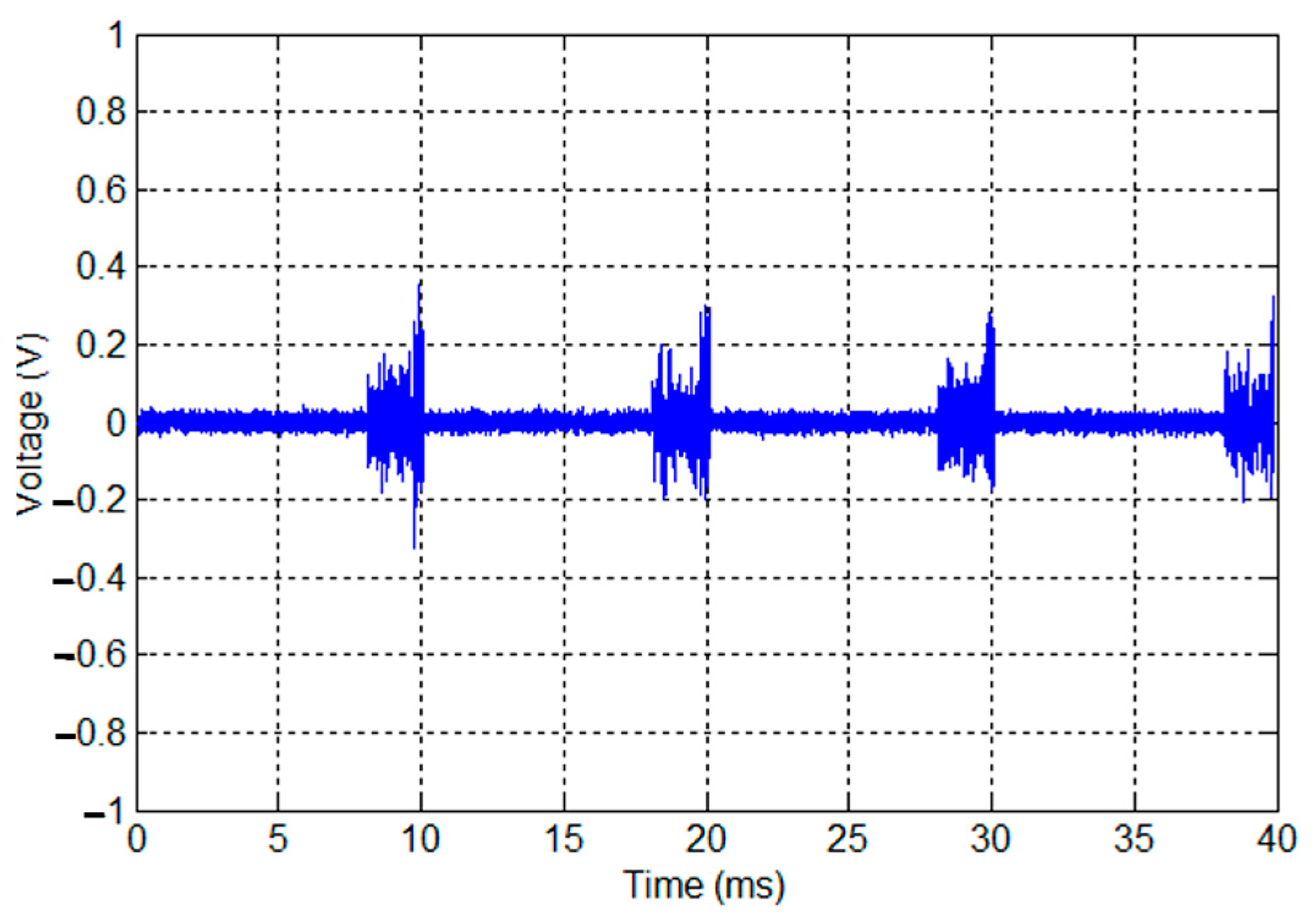

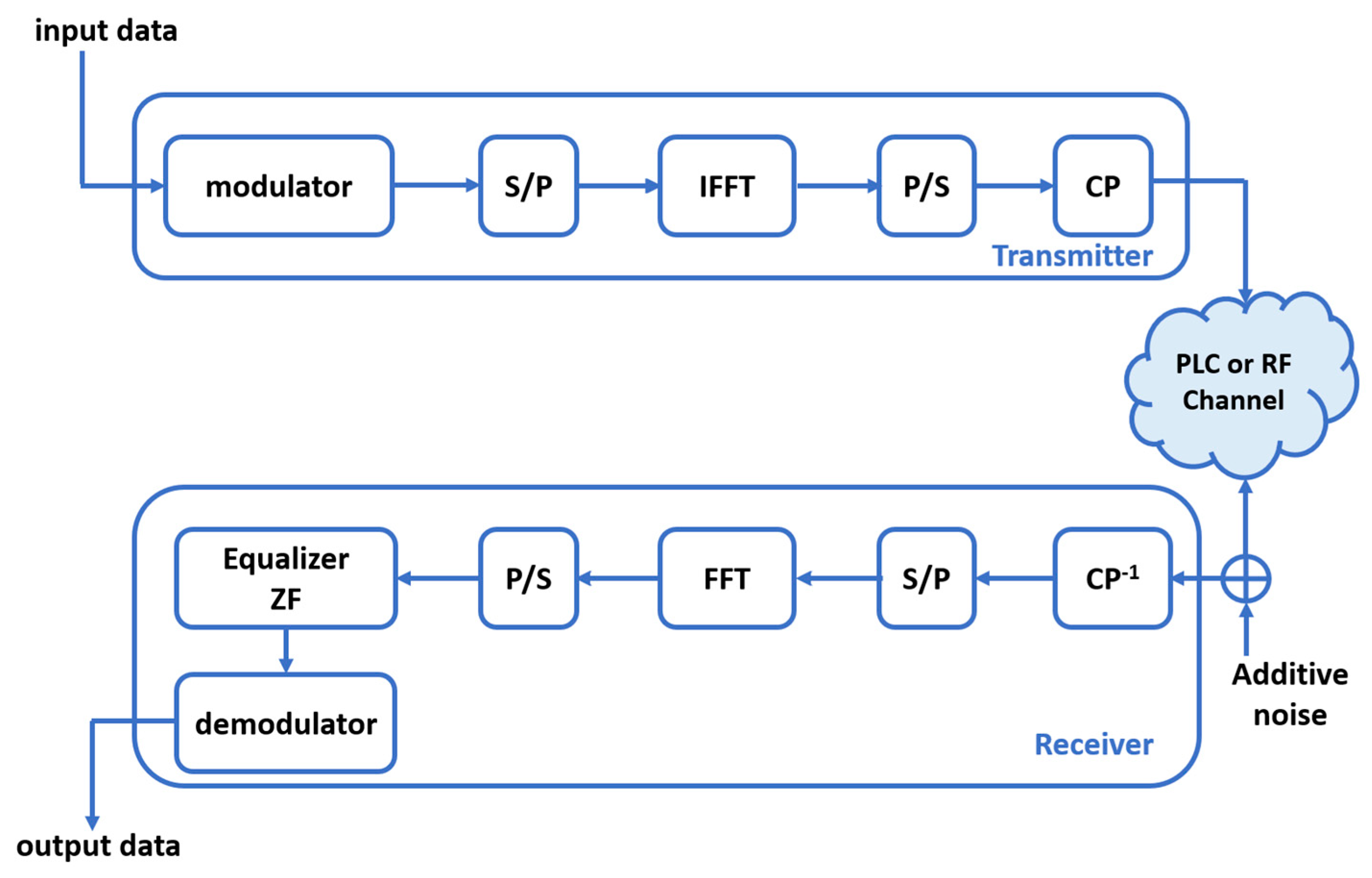

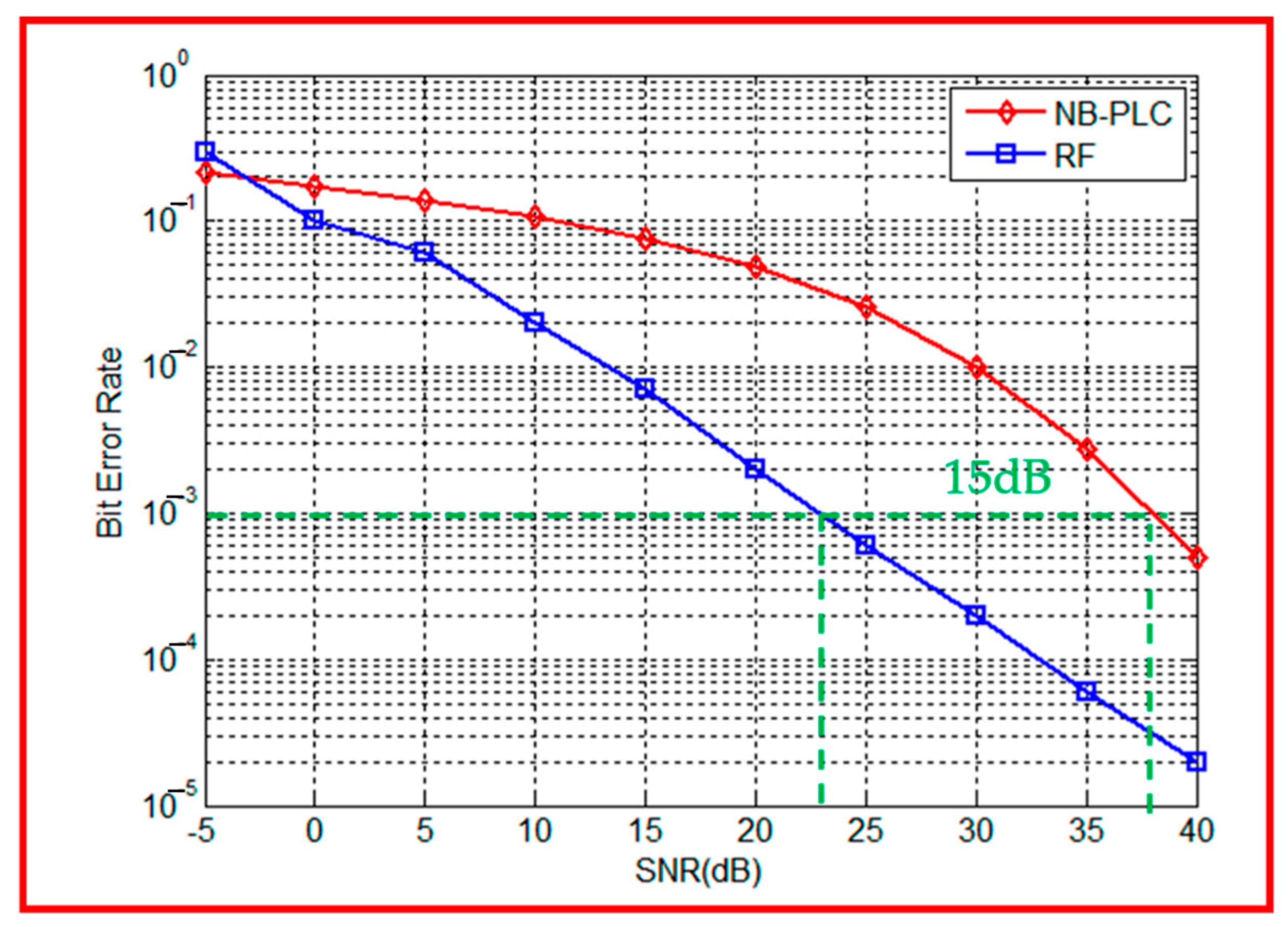
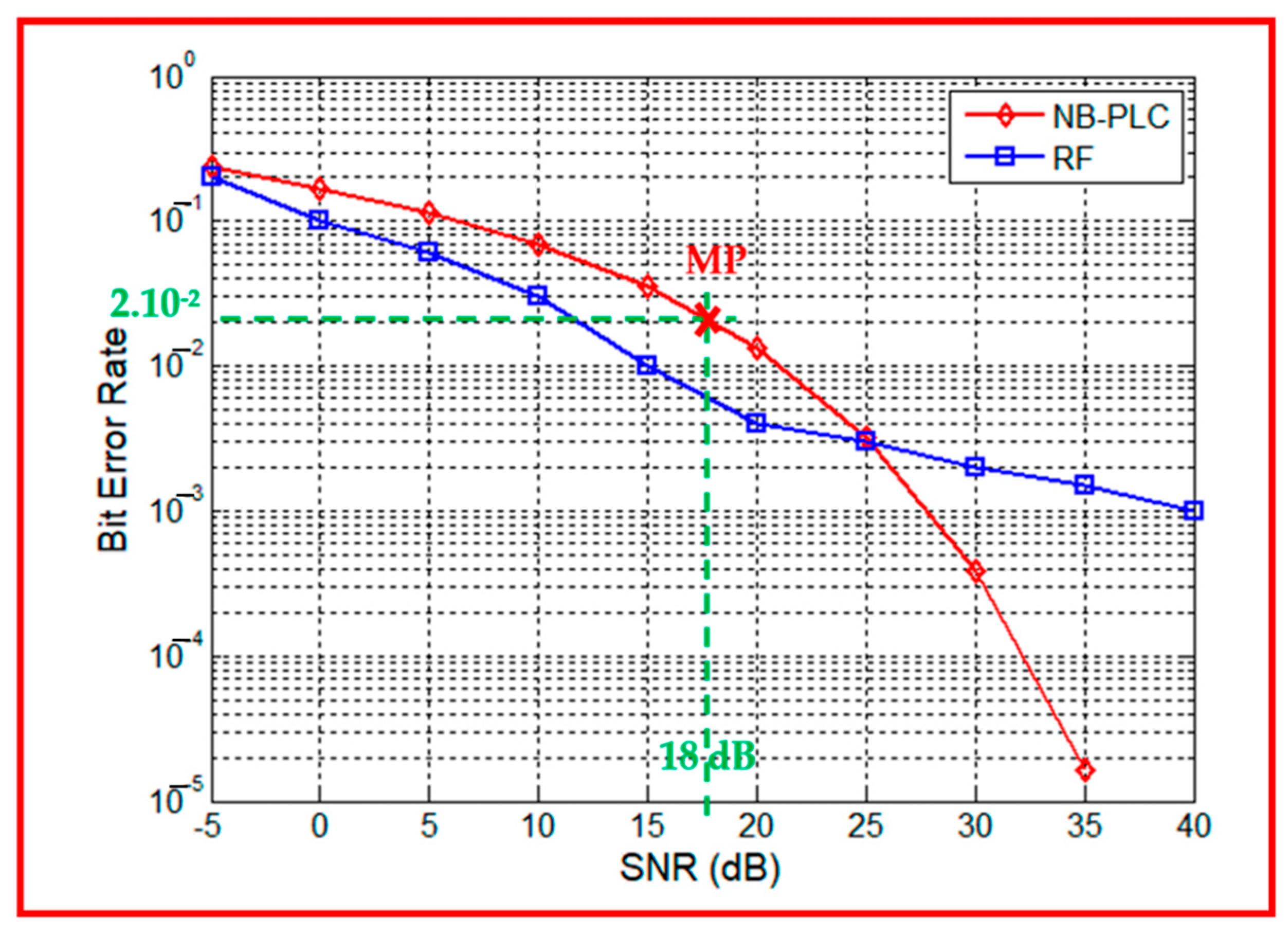

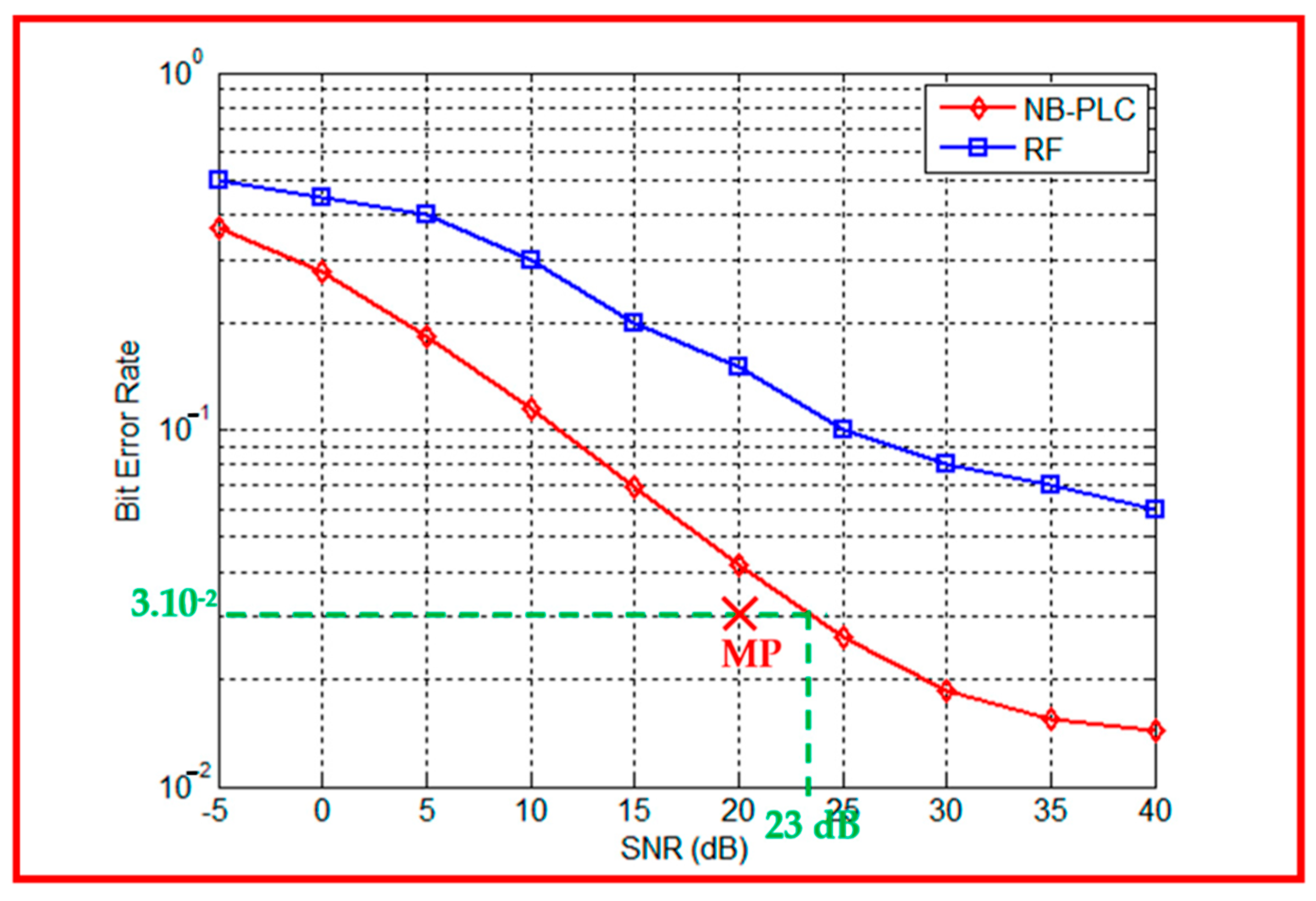
| Technology | Frequency Band | Average Data Rate | Average Latency | Standards |
|---|---|---|---|---|
| NB-PLC | 3–500 kHz | 200 kbps | 150 ms | PRIME, G3-PLC/IEEE 1901.2, ITU-T G.hnem |
| BB-PLC | 2–30 MHz | 100 Mbps | 200–400 ms | IEEE1901, ITU-T G.hnem |
| Optical Fiber | >1 THz | Up to 10 Gbps | 5 μs | Ethernet 10GBASE-SR |
| WiMAX | 2–11 GHz | 75 Mbps | 10–50 ms | IEEE 802.16, IEEE 802.16d |
| RF Mesh | 900 MHz | 10–100 kbps | 700 ms | IEEE 802.11, IEEE 802.15 |
| LTE | 900 MHz | 384 kbps | 100 ms | LTE-M |
| 3G | 800 MHz | Up to 14.7 Mbps | 120 ms | UMTS |
| Region | Percentage |
|---|---|
| R1 | 70% |
| R2 | 20% |
| R3 | 10% |
| Area | SM-DC Distance | RF Path Number | RF Noise Model | NB-PLC Line Length | NB-PLC Noise Model |
|---|---|---|---|---|---|
| Rural | 1 km | 5 | AWGN | >200 m | AWGN |
| Urban | 80 m–200 m | 10–20 | AWGN/GMM | 20–50 m | Cyclostationary Impulsive Noise |
| Industrial | 50 m | 40–50 | GMM | <15 m | Cyclostationary Impulsive Noise |
Disclaimer/Publisher’s Note: The statements, opinions and data contained in all publications are solely those of the individual author(s) and contributor(s) and not of MDPI and/or the editor(s). MDPI and/or the editor(s) disclaim responsibility for any injury to people or property resulting from any ideas, methods, instructions or products referred to in the content. |
© 2023 by the authors. Licensee MDPI, Basel, Switzerland. This article is an open access article distributed under the terms and conditions of the Creative Commons Attribution (CC BY) license (https://creativecommons.org/licenses/by/4.0/).
Share and Cite
BenRhouma, O.; Rebai, C.; Ben-Romdhane, M.; Di Cara, D.; Artale, G.; Panzavecchia, N. The Environmental Impacts of Radio Frequency and Power Line Communication for Advanced Metering Infrastructures in Smart Grids. Sensors 2023, 23, 9621. https://doi.org/10.3390/s23249621
BenRhouma O, Rebai C, Ben-Romdhane M, Di Cara D, Artale G, Panzavecchia N. The Environmental Impacts of Radio Frequency and Power Line Communication for Advanced Metering Infrastructures in Smart Grids. Sensors. 2023; 23(24):9621. https://doi.org/10.3390/s23249621
Chicago/Turabian StyleBenRhouma, Ons, Chiheb Rebai, Manel Ben-Romdhane, Dario Di Cara, Giovanni Artale, and Nicola Panzavecchia. 2023. "The Environmental Impacts of Radio Frequency and Power Line Communication for Advanced Metering Infrastructures in Smart Grids" Sensors 23, no. 24: 9621. https://doi.org/10.3390/s23249621





